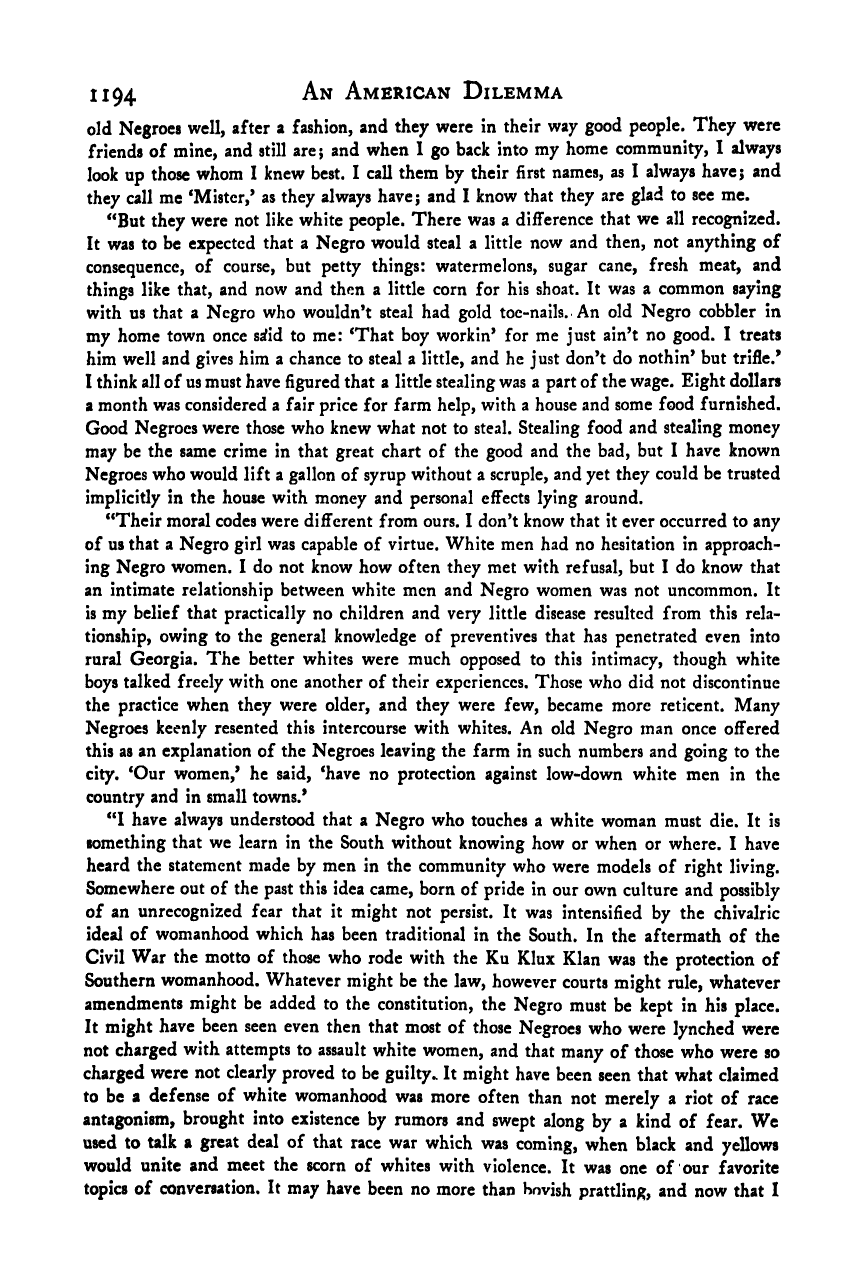Note: Gunnar Myrdal died in 1987, less than 70 years ago. Therefore, this work is protected by copyright, restricting your legal rights to reproduce it. However, you are welcome to view it on screen, as you do now. Read more about copyright.
Full resolution (TIFF) - On this page / på denna sida - Footnotes - Chapter 4

<< prev. page << föreg. sida << >> nästa sida >> next page >>
Below is the raw OCR text
from the above scanned image.
Do you see an error? Proofread the page now!
Här nedan syns maskintolkade texten från faksimilbilden ovan.
Ser du något fel? Korrekturläs sidan nu!
This page has never been proofread. / Denna sida har aldrig korrekturlästs.
1194 An American Dilemma
old Negroes well, after a fashion, and they were in their way good people. They were
friends of mine, and still are; and when 1 go back into my home community, I always
look up those whom I knew best. I call them by their first names, as I always have; and
they call me ‘Mister,’ as they always have; and I know that they are glad to see me.
“But they were not like white people. There was a difference that we all recognized.
It was to be expected that a Negro would steal a little now and then, not anything of
consequence, of course, but petty things: watermelons, sugar cane, fresh meat, and
things like that, and now and then a little corn for his shoat. It was a common saying
with us that a Negro who wouldn’t steal had gold toe-nails. An old Negro cobbler in
my home town once safid to me: ‘That boy workin’ for me just ain’t no good. I treats
him well and gives him a chance to steal a little, and he just don’t do nothin’ but trifle.’
I think all of us must have figured that a little stealing was a part of the wage. Eight dollars
a month was considered a fair price for farm help, with a house and some food furnished.
Good Negroes were those who knew what not to steal. Stealing food and stealing money
may be the same crime in that great chart of the good and the bad, but I have known
Negroes who would lift a gallon of syrup without a scruple, and yet they could be trusted
implicitly in the house with money and personal effects lying around.
“Their moral codes were different from ours. I don’t know that it ever occurred to any
of us that a Negro girl was capable of virtue. White men had no hesitation in approach-
ing Negro women. I do not know how often they met with refusal, but I do know that
an intimate relationship between white men and Negro women was not uncommon. It
is my belief that practically no children and very little disease resulted from this rela-
tionship, owing to the general knowledge of preventives that has penetrated even into
rural Georgia. The better whites were much opposed to this intimacy, though white
boys talked freely with one another of their experiences. Those who did not discontinue
the practice when they were older, and they were few, became more reticent. Many
Negroes keenly resented this intercourse with whites. An old Negro man once offered
this as an explanation of the Negroes leaving the farm in such numbers and going to the
city. ‘Our women,’ he said, ‘have no protection against low-down white men in the
country and in small towns.’
“I have always understood that a Negro who touches a white woman must die. It is
something that we learn in the South without knowing how or when or where. I have
heard the statement made by men in the community who were models of right living.
Somewhere out of the past this idea came, born of pride in our own culture and possibly
of an unrecognized fear that it might not persist. It was intensified by the chivalric
ideal of womanhood which has been traditional in the South. In the aftermath of the
Civil War the motto of those who rode with the Ku Klux Klan was the protection of
Southern womanhood. Whatever might be the law, however courts might rule, whatever
amendments might be added to the constitution, the Negro must be kept in his place.
It might have been seen even then that most of those Negroes who were lynched were
not charged with attempts to assault white women, and that many of those who were so
charged were not clearly proved to be guilty. It might have been seen that what claimed
to be a defense of white womanhood was more often than not merely a riot of race
antagonism, brought into existence by rumors and swept along by a kind of fear. We
used to talk a great deal of that race war which was coming, when black and yellows
would unite and meet the scorn of whites with violence. It was one of our favorite
topics of conversation. It may have been no more than bovish prattling, and now that I
<< prev. page << föreg. sida << >> nästa sida >> next page >>